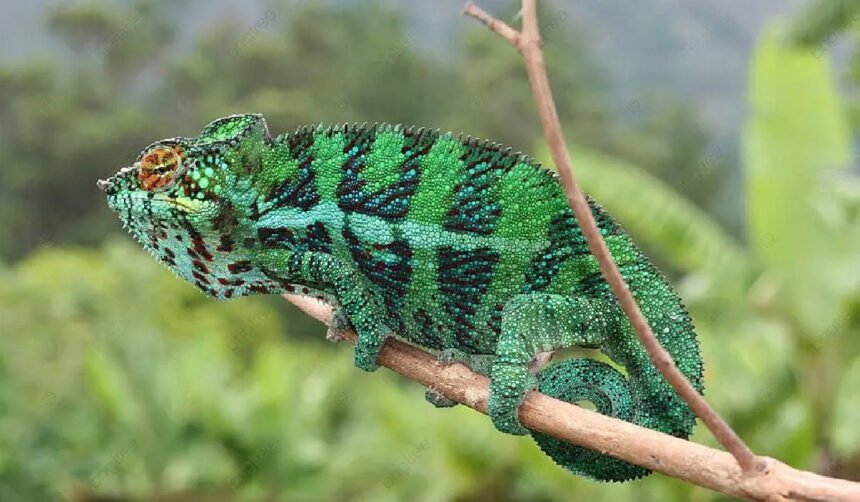What Is Chameleónovité?
Chameleónovité is the Slovak term referring to the Chamaeleonidae family—a remarkable group of reptiles known for their unique ability to change color, rotate their eyes independently, and capture prey using a long, sticky tongue. These arboreal reptiles belong to the order Squamata and the suborder Iguania, which includes other lizards such as iguanas and agamids. With over 200 recognized species, chameleónovité represent a fascinating and highly evolved branch of the reptile kingdom, adapted specifically for life in the treetops of tropical forests, particularly in Madagascar, Sub-Saharan Africa, and parts of southern Europe and Asia.
The name “chameleónovité” reflects regional linguistic usage, particularly in Slovak-speaking and Central European contexts, where it emphasizes both scientific taxonomy and localized familiarity. These reptiles are admired worldwide not just for their incredible camouflage abilities, but also for their unparalleled vision, communication methods, and ecological significance. Whether it’s their shimmering skin or telescopic tongues, every feature of chameleónovité is designed for one thing: survival through evolutionary mastery.
Evolutionary Origins of the Chameleon Family
The story of chameleónovité stretches back over 65 million years, emerging during the late Cretaceous period when ancient reptiles diversified into various ecological niches. Fossil evidence indicates that the earliest ancestors of chameleons likely evolved on the island of Madagascar, which is home to the richest diversity of modern chameleon species. From there, they radiated across Africa, with some lineages reaching parts of Asia and southern Europe.
This evolutionary journey highlights the power of natural selection and adaptive radiation, as different species of chameleónovité developed distinct physical and behavioral traits suited to their specific environments. Belonging to the Iguania suborder, chameleons share distant relations with other lizards but stand apart due to their highly specialized arboreal adaptations.
Their spread into a variety of ecological zones—from humid rainforests to dry savannas—demonstrates the versatility of their genetic blueprint and the evolutionary pressures that sculpted their exceptional abilities.
Unique Anatomy of Chameleónovité – Built for Survival
The anatomical features of chameleónovité are nothing short of a masterpiece in reptilian design. Their zygodactylous feet—with toes grouped in opposable pairs—allow them to firmly grip branches, giving them unrivaled control in treetop environments. Additionally, their prehensile tail acts as a fifth limb, curling securely around branches to help maintain balance during slow, deliberate movements.
One of the most incredible features is their projectile tongue, which can extend at lightning speed to capture prey at distances over twice their body length. This tongue is powered by specialized accelerator muscles and a bone called the entoglossal process, allowing for rapid extension and retraction with pinpoint accuracy. The conical, turret-like eyes rotate independently, giving them a full 360-degree visual field—a rare trait in the animal kingdom.
Their skeleton and musculature are adapted for stability rather than speed, reflecting their stealth-based lifestyle. In every detail, chameleónovité display traits that are tailored for an elevated life among the branches, making them some of the most refined arboreal reptiles in existence.
The Science Behind Color Change in Chameleons
One of the most mesmerizing features of chameleónovité is their ability to change color, a trait often misrepresented as mere camouflage. In reality, color change in chameleons is a sophisticated form of biological communication and thermoregulation. Underneath their outer skin, chameleons have specialized cells called chromatophores, which contain pigments like melanin, as well as iridophores, which reflect light through nanoscale crystals.
By altering the spacing of these nanocrystals, chameleons can manipulate how light bounces off their skin, effectively changing their color from bright reds and yellows to muted greens and browns. This mechanism serves several purposes: they use color shifts to signal aggression, attract mates, cool or warm their bodies, and express mood or stress. For example, a male Panther chameleon in a mating display might radiate electric blues and oranges, while a stressed chameleon may darken its body.
Scientists studying chameleon physiology continue to unlock secrets of these dynamic skin cells, leading to breakthroughs in bio-inspired materials like smart fabrics and adaptive surfaces. Chameleónovité truly are living canvases of nature’s most advanced engineering.
Visual System: The Eyes of Chameleónovité
The eyes of chameleónovité are among the most distinctive and advanced in the entire reptile world. Unlike most vertebrates, each chameleon eye can move independently, scanning in two different directions at once. This grants them a panoramic, 360-degree field of vision, enabling them to monitor predators and locate prey without moving their heads—a vital survival tool in the wild. When targeting prey, both eyes lock forward to provide precise depth perception, a phenomenon called binocular vision, allowing accurate estimation of distance for their high-speed tongue strike. Furthermore, chameleons have exceptional visual acuity and can even detect ultraviolet light, which plays a role in social signaling and feeding. Their eyes are set in turret-like sockets, giving them a unique appearance and allowing complete rotational movement. This incredible vision system is essential to their slow-moving, stealth-based hunting strategy and is considered one of the most complex and efficient in the reptilian kingdom. For researchers, chameleónovité eyes offer insight into neurological coordination, perception, and evolutionary development of visual systems.
Life in the Canopy – Chameleon Habitats and Distribution
Chameleónovité are predominantly arboreal, meaning they live in trees, although a few ground-dwelling species exist. The island of Madagascar is the epicenter of their diversity, with nearly half of all known chameleon species found there, including many that are endemic (found nowhere else). Beyond Madagascar, chameleons are widespread across Sub-Saharan Africa, with select populations in southern Europe (like the Iberian Peninsula), the Arabian Peninsula, and South Asia.
Chameleons inhabit a wide range of ecosystems including rainforests, montane forests, dry savannas, and even semi-arid deserts. Each habitat demands specific adaptations, and chameleónovité have evolved accordingly—with variations in size, skin texture, and coloration that align with their environment. For instance, forest-dwelling species often display vibrant colors, while desert species adopt more subdued tones for better camouflage. The ability of chameleónovité to inhabit such diverse ecological zones is a testament to their adaptive versatility and evolutionary success.
Chameleon Behavior: Solitary, Stealthy, Strategic
The behavior of chameleónovité is marked by solitude, patience, and precision. These reptiles are primarily solitary, preferring to live and hunt alone, and are highly territorial—especially males, who will use dramatic color displays and body postures to warn rivals.
Movement is deliberately slow and calculated, designed to avoid detection by predators and not startle prey. This stealthy approach, combined with their camouflage abilities, allows them to blend into their surroundings and wait motionless for hours. Chameleons are diurnal, meaning they are active during the day and rely on light for navigation and hunting.
Their cautious and contemplative way of life reflects a deep evolutionary commitment to energy efficiency, low visibility, and maximum effectiveness in the wild. They represent a survival strategy based not on speed or strength, but on strategic stillness and smart use of their surroundings—a behavior that continues to fascinate animal behaviorists and naturalists.
Feeding and Hunting: Masters of Precision
When it comes to feeding, chameleónovité are insectivorous specialists with an extraordinary biological weapon: the projectile tongue. This tongue, which can extend up to twice the length of the chameleon’s body, is stored coiled inside the mouth and powered by a hydraulic-like system of muscles and elastic tissue. When prey is spotted, the tongue launches at speeds up to 13 miles per hour (21 kph), capturing insects in milliseconds with its sticky, suction-cup-like tip.
Larger species of chameleons may also feed on small birds, lizards, or invertebrates. Their diet varies depending on habitat and season, and they play an important ecological role as natural pest controllers. In forest ecosystems, they help regulate insect populations, maintaining a healthy balance. The way chameleónovité hunt is a blend of silence, focus, and lightning-fast action, showing how a reptile once considered slow has become a symbol of biomechanical excellence.
Courtship and Reproduction in Chameleónovité
Reproduction in chameleónovité is a dynamic display of color, communication, and instinct. During mating season, males use their vivid coloration to attract females or intimidate rivals. These color displays can become intense, signaling genetic fitness or warning signs. When a female is receptive, mating occurs with minimal physical interaction, followed by a solitary nesting process. Most chameleons are oviparous, laying 10 to 50 eggs in shallow soil or leaf litter.
However, certain mountain species are ovoviviparous, meaning they give birth to live young. Incubation periods vary by species and climate, ranging from a few weeks to several months. Once hatched, baby chameleons are fully independent and receive no parental care. Their survival depends on instinct and immediate adaptation to their environment. This reproductive diversity across chameleónovité species showcases their ecological intelligence and resilience, ensuring that their line continues across generations in ever-changing ecosystems.
Endangered Beauty: Conservation Challenges
Despite their captivating qualities, chameleónovité face increasing threats in the modern world. Chief among these are habitat loss, deforestation, and climate change, especially in biodiversity hotspots like Madagascar. Agricultural expansion, illegal logging, and urban development continue to shrink the forests that chameleons call home. Additionally, the exotic pet trade places pressure on wild populations, with several species being captured unsustainably for commercial sale. Species like Calumma tarzan and Brookesia nana are already listed as critically endangered on the IUCN Red List.
International efforts under CITES (Convention on International Trade in Endangered Species) aim to regulate trade, but enforcement remains a challenge. Conservation organizations are working to preserve habitats, support captive breeding programs, and educate local communities. Protecting chameleónovité is not only about saving a single group of reptiles—it’s about safeguarding entire ecosystems, cultural heritage, and biological wonders that cannot be replaced once lost.
Chameleónovité in Human Culture, Science, and Art
Chameleónovité have captivated human imagination for centuries, not only for their striking appearance but also for their symbolic meanings. Across ancient and modern cultures, chameleons have often been seen as emblems of adaptability, intuition, and transformation. In African folklore, they were sometimes thought to carry messages from the gods due to their mystical ability to change color. In contemporary art and literature, chameleons are used as metaphors for people who adapt to changing social environments or situations.
Beyond symbolism, chameleónovité have had a real impact on modern science and technology, especially in the fields of biomimicry and material design. Engineers and scientists study chameleon skin to develop smart fabrics, color-shifting sensors, and even soft robotics that react to environmental conditions. Their remarkable eye movements have also inspired advancements in optical tracking systems. In this way, chameleónovité bridge the gap between biology and innovation, continuing to influence not only how we view nature but also how we design future technologies.
Chameleons as Pets – Rewards and Responsibilities
Keeping chameleónovité as pets can be both rewarding and challenging. While their mesmerizing looks and calm nature make them appealing to exotic pet lovers, they require very specific care conditions to remain healthy. Popular pet species include the Veiled Chameleon (Chamaeleo calyptratus), Panther Chameleon (Furcifer pardalis), and Jackson’s Chameleon (Trioceros jacksonii). These species are more adaptable to captivity but still need high humidity, precise temperatures, UVB lighting, and a vertical enclosure with plants and branches for climbing. Their diet must consist of live insects like crickets, roaches, and mealworms, often dusted with calcium supplements to prevent bone disorders.
Chameleons are also sensitive to stress and should not be handled frequently. Importantly, pet owners should choose captive-bred chameleons from reputable breeders, not wild-caught ones, which can damage natural populations and are more prone to disease. For beginners, it’s highly recommended to do thorough research and consult herpetologists before taking on the responsibility of caring for chameleónovité at home. When cared for properly, they can live 5 to 10 years, offering a unique and educational companionship experience.
Fascinating Chameleon Species to Know
The chameleónovité family is home to an astonishing variety of species, each with its own unique adaptations, colors, and behaviors. Here are some of the most notable ones:
| Species Name | Region | Size | Special Feature |
|---|---|---|---|
| Brookesia micra | Madagascar | 2.5 cm | One of the smallest vertebrates in the world |
| Furcifer pardalis | Madagascar | 20–25 cm | Bright, varied colors; common in pet trade |
| Chamaeleo calyptratus | Yemen, Saudi Arabia | 30–60 cm | Distinct casque on head; hardy pet species |
| Trioceros jacksonii | Kenya, Tanzania | 25–35 cm | Three facial horns; live-bearing species |
| Calumma parsonii | Madagascar | 60–70 cm | Largest chameleon; slow-moving and gentle |
These species show just how diverse and specialized chameleónovité can be, ranging from nearly invisible forest dwellers to bold, colorful tree climbers. Each one plays a role in maintaining its local ecosystem and continues to intrigue scientists and animal lovers alike.
Latest Scientific Discoveries and Innovations
In recent years, chameleónovité have become the focus of exciting scientific breakthroughs. Researchers in 2024 and 2025 have made new discoveries about how chameleon skin works on a molecular level. A study from the University of Geneva revealed even more detail about the nanocrystal arrangements that control light reflection in their iridophores, leading to insights that are now helping engineers create temperature-sensitive clothing and adaptive camouflage materials.
Meanwhile, genomic studies are helping scientists map the DNA of various chameleon species, revealing genetic codes behind their color changes, size, and even resistance to certain diseases. Field biologists also recently discovered new chameleon species in remote parts of Madagascar and Tanzania—proof that we still have much to learn about their diversity.
Conservation biologists are now using AI-powered habitat modeling to predict how climate change might affect where chameleónovité can live in the future. These innovations underline just how important chameleons are not only in biodiversity but also in technology, climate science, and medical research.
How You Can Help Save Chameleónovité
Anyone who admires chameleónovité can play a role in their conservation. One of the most important things you can do is support organizations like the Durrell Wildlife Conservation Trust, WWF Madagascar, or Madagasikara Voakajy, all of which work directly to protect chameleon habitats through reforestation, community education, and policy advocacy.
If you’re thinking about owning a chameleon, always choose captive-bred individuals from ethical breeders and never buy from illegal wildlife traders. You can also help by spreading awareness—many people still don’t know that chameleons are at risk due to habitat destruction, climate change, and the exotic pet trade.
Another way to contribute is by supporting sustainable ecotourism in Madagascar and Africa, which gives local communities an incentive to protect chameleon habitats. Even small actions—like reducing your carbon footprint, donating to wildlife projects, or educating your friends—can add up. Saving chameleónovité means saving a living link to evolution’s wonders, and every action helps protect their future.
Final Thoughts
Chameleónovité are more than just color-changing reptiles—they are living examples of evolution’s brilliance and nature’s creativity. From their microscopic skin crystals to their panoramic vision and prehensile tails, every feature of a chameleon serves a purpose and tells a story.
These creatures represent the beauty of balance in nature: bold and visible when signaling, yet silent and hidden when surviving. Their ability to thrive in treetops, adapt to microhabitats, and evolve over millions of years makes them one of the most inspiring species on Earth. But their future depends on us.
As forests vanish and climate patterns shift, chameleónovité stand at a crossroads—one path leads to extinction, the other to survival through awareness and action. Whether through science, education, conservation, or admiration, we all have a role to play in preserving these living jewels. To protect chameleons is to protect biodiversity, ecosystems, and the very fabric of the natural world we all share.
FAQs About Chameleónovité
Q1: What is chameleónovité?
A: Chameleónovité is the Slovak name for the Chamaeleonidae family — a group of reptiles known as chameleons. They are famous for changing colors, moving their eyes in different directions, and catching insects with long sticky tongues. Most species live in Madagascar and Africa.
Q2: Why do chameleónovité change color?
A: Chameleons change color mainly to communicate, control body temperature, and show emotions like stress or excitement. The color change happens through special skin cells called chromatophores that reflect light in different ways.
Q3: Where do chameleónovité live?
A: Chameleónovité are mostly found in tropical regions, especially in Madagascar, Sub‑Saharan Africa, southern Europe, and parts of Asia. They live in trees and bushes, where their colors help them blend with leaves and branches.
Q4: What do chameleónovité eat?
A: Chameleons mainly eat insects such as crickets, flies, and grasshoppers. Larger species sometimes eat small birds or other reptiles. They use their long, fast tongue to catch prey from a distance.
Q5: Are chameleónovité endangered?
A: Yes, some chameleon species are endangered due to deforestation, climate change, and illegal pet trading. Conservation programs and protected habitats are helping to keep these amazing reptiles safe for the future.
You may also read: Darlnaija: The Ultimate Guide to Nigeria’s Vibrant Culture and Creativity
For More Information, Visit Dotmagazine









